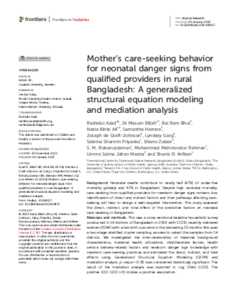
Background:
Neonatal deaths contribute to nearly half (47%) of under-five mortality globally and 67% in Bangladesh. Despite high neonatal mortality, care-seeking from qualified providers for newborn danger signs remains low. Identification of direct and indirect factors and their pathways affecting care-seeking will help to design a well-targeted intervention. This study assessed the direct, indirect, and total effect of the predictive factors on neonatal care-seeking in Bangladesh.
Materials and methods:
This was a cross-sectional baseline household survey conducted in 14 districts of Bangladesh in 2019 with 17,251 recently delivered women (RDW) with a live birth outcome in the preceding 15 months. We used a two-stage stratified cluster sampling process to select the samples from 14 districts. We investigated the inter-relationship of maternal background characteristics, maternal health utilizations, child/neonate factors, health service delivery-related factors and newborn danger sign knowledge with newborn care-seeking practices and estimated the direct, indirect, and total effects using Generalized Structural Equation Modeling (GSEM) and mediation analysis. p-value = 0.05 was considered statistically significant. The result of the mediation analysis was reported in Log Odds (LOD). The positive LOD (LOD > 0) implies a positive association.
Results:
Half of the mothers (50.8%) reported a neonatal illness and among them, only 36.5% mothers of sick neonates sought care from qualified providers. Our mediation analysis showed that maternal health utilization factors, i.e., 4 + antenatal care visits (ANC) from a qualified provider (LOD: 0.63, 95% CI: 0.49, 0.78), facility delivery (LOD: 0.74, 95% CI: 0.30, 1.17) and postnatal care (PNC) from a qualified provider (LOD: 0.50, 95% CI: 0.21, 0.78) showed the highest total effect over other factors domains, and therefore, were the most important modifiable predictors for qualified neonatal care-seeking. Other important factors that directly and/or indirectly increased the chance of newborn care-seeking from qualified providers were household wealth (LOD: 0.86, 95% CI: 0.70, 1.02), maternal education (LOD: 0.48, 95% CI: 0.32, 0.63), distance to nearest health facility (LOD: 0.20, 95% CI: 0.10, 0.30), community health worker’s (CHWs) home visits during ANC (LOD: 0.24, 95% CI: 0.13, 0.36), neonatal danger sign counseling after delivery (LOD: 0.20, 95% CI: 0.06, 0.34) and women’s knowledge of neonatal danger signs (LOD: 0.37, 95% CI: 0.09, 0.64).